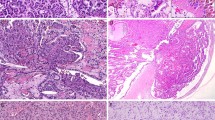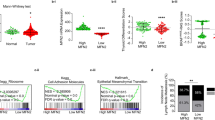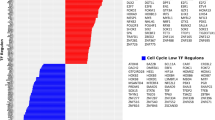Abstract
We recently described germline and somatic mutations in the MET gene associated with papillary renal carcinoma type 1. MET mutation M1268T was located in a codon highly conserved among receptor tyrosine kinases, and homologous to the codon mutated in multiple endocrine neoplasia type 2B, and many cases of sporadic medullary carcinoma of the thyroid gland (Ret M918T). Ret M918T and MET M1268T have previously been shown to be highly active in mouse NIH3T3 transformation assays, and to change the substrate specificity of the kinase. We studied the mechanism of transformation mediated by MET M1268T by analysing a clone, F4, derived from NIH3T3 cells transformed by MET M1268T. In contrast to NIH3T3 cells, F4 cells grew in suspension in tissue culture, and rapidly formed tumors in nude mice. We found that c-Src was constitutively bound to MET proteins in F4 cells, and that Src kinase activity was elevated. Transfection of dominant negative Src constructs into F4 cells eliminated the ability of F4 cells to grow in suspension culture and retarded the growth of F4 cells in vivo. The ability of transfected dominant negative Src constructs to inhibit the growth of F4 cells correlated with the inhibition of phosphorylation of paxillin and focal adhesion kinase. Transfection of dominant negative Src constructs into F4 cells had no effect on Grb2 binding or PLC γ phosphorylation. The results suggest that c-Src participates in the tumorigenic phenotype induced in NIH3T3 cells by MET M1268T by signaling through focal adhesion kinase and paxillin.
This is a preview of subscription content, access via your institution
Access options
Subscribe to this journal
Receive 50 print issues and online access
$259.00 per year
only $5.18 per issue
Buy this article
- Purchase on SpringerLink
- Instant access to full article PDF
Prices may be subject to local taxes which are calculated during checkout







Similar content being viewed by others
References
Bardelli A, Longati P, Gramaglia D, Basilico C, Tamagnone L, Giordano S, Ballinari D, Michieli P and Comoglio M . 1998 Proc Natl Acad Sci USA 95: 14379–14383
Bentz M, Bergerheim US, Li C, Joos S, Wemer CA, Baduis M, Gnarra J, Merino MJ, Zbar B, Linehan WM and Lichter P . 1996 Cytogenet Cell Genet 75: 17–21
Bottaro DP, Rubin JS, Faletto DI L, Chan AM, Kmiecik TE, Vande Woude GF and Aaronson SA . 1991 Science 251: 802–804
Brinkman V, Foroutan H, Sachs M, Weidner KM and Birchmeier W . 1995 J Cell Biol 131: 1573–1586
Di Renzo MF, Olivero M, Giacomini A, Porte H, Chastre E, Mirossay L, Nordlinger B, Bretti S, Bottardi S, Giordano S, et al. 1995 Clin Cancer Res 1: 147–154
Gherardi E and Stoker M . 1991 Cancer Cells 3: 227–232
Gould KL, Cooper JA, Bretscher A and Hunter T . 1986 J Cell Biol 102: 660–669
Hamaguch M and Hanafysa H . 1987 Proc Natl Acad Sci USA 82: 2312–2316
Jeffers M, Rong S and Vande Woude GF . 1996 J Mol Med 74: 505–513
Jeffers M, Schmidt L, Nakaigawa N, Web CP, Weirich G, Kishida T, Zbar B and Vande Woude GF . 1997 Proc Natl Acad Sci USA 94: 11445–11450
Jeffers M and Vande Woude GF . 1999 Oncogene 18: 5120–5125
Jeffers M, Koochekpour S, Fiscella M, Sathyanarayana BK and Vande Woude GF . 1998a Oncogene 17: 2691–2700
Kaplan KB, Bibbins K, Swedlow JR, Amaud M, Morgan DO and Varmus HE . 1994 EMBO J 13: 4745–4756
Kaplan KB, Swedlow JR, Morgan DO and Varmus HE . 1995 Genes Dev 9: 1505–1517
Kovacs G . 1993 Adv Cancer Res 62: 89–124
Lubensky IA, Schmidt L, Zhuang Z, Weirich G, Pack S, Zambrano N, Walther MM, Choyke P, Linehan WM and Zbar B . 1999 Am J Pathol 155: 517–526
Oude Weemink PA and Rijksen G . 1995 J Biol Chem 270: 2264–2267
Pasquale EB, Maher PA and Singer SJ . 1986 Proc Natl Acad Sci USA 83: 5507–5511
Ponzetto C, Bardelli A, Zhen Z, Maina F, Zonca P, Giordano S, Graziani A, Panayotou G and Comoglio PM . 1994 Cell 77: 261–271
Rahimi N, Hung W, Tremblay E, Saulnier R and Elliott B . 1998 J Biol Chem 273: 33714–33721
Rubin JS, Bottaro DP and Aaronson SA . 1993 Biochim Biophys Acta 1155: 357–371
Santoro MM, Penengo L, Minetto M, Orecchia S, Cilli M and Gaudino G . 1998 Oncogene 17: 741–749
Schmidt L, Duh F-M, Chen F, Kishida T, Glenn G, Choyke P, Scherer SW, Zhuang Z, Lubensky I, Dean M, Allilments R, Chidambaram A, Bergerheim UR, Feltis JT, Casadevall C, Zamarron A, Bernues M, Richard S, Lips CJM, Walter MM, Tsui L-C, Geil L, Orcutt ML, Stackhouse T, Lipan J, Slife L, Brauch H, Decker J, Niehans G, Hughson MD, Moch H, Storkel S, Lerman MI, Linehan WM and Zbar B . 1997 Nature Genet 16: 68–73
Schmidt L, Junker K, Nakaigawa N, Kinjerski T, Weirich G, Miller M, Lubinsky I, Neumann HP, Brauch H, Decker J, Vocke C, Brown JA, Jenkins R, Richard S, Bergerheim U, Gerrard B, Dean M, Lineham WM and Zbar B . 1999 Oncogene 18: 2343–2350
Sefton BM, Hunter T, Ball EH and Singer SJ . 1981 Cell 24: 165–174
Turner CE, Glenney JR and Burridge K . 1990 J Biol Cell 11: 1059–1068
Williams TA, Longati P, Pugliese L, Gual P, Bardelli A and Michieli P . 1999 J Cell Physiol 181: 507–514
Wu H, Reynolds AB, Kanner SB, Vines RR and Parsons T . 1991 Mol Cell Biol 11: 5113–5124
Zbar B, Tory K, Merino M, Schmidt L, Gxnn G, Choyke P, Walther MM, Lerman M and Linehan WM . 1994 J Urol 151: 561
Zbar B and Lerman M . 1998 Adv Cancer Res 75: 164–201
Zhu H, Naujokas MA, Fixman ED, Torossian K and Park M . 1994 J Biol Chem 269: 29943–29948
Acknowledgements
We thank Mike Jeffers and George Vande Woude for helpful discussion and for MET expression vector, Alla Danilkovitch for the critical reading of manuscript, Kenneth B Kaplan for dominant negative Src expression vectors, and W Gregory Alvord for statistical study. The content of this publication does not necessarily reflect the views or policies of the Department of Health and Human Services, nor does mention of trade names, commercial products, or organizations imply endorsement by the US Government. This project has been funded in part with Federal Funds from the National Cancer Institute, National Institutes of Health, under Contract No. NO1-CO-56000. The publisher or recipient acknowledges right of the US Government to retain a nonexclusive, royalty-free license in and to any copyright covering the article.
Author information
Authors and Affiliations
Rights and permissions
About this article
Cite this article
Nakaigawa, N., Weirich, G., Schmidt, L. et al. Tumorigenesis mediated by MET mutant M1268T is inhibited by dominant-negative Src. Oncogene 19, 2996–3002 (2000). https://doi.org/10.1038/sj.onc.1203628
Received:
Revised:
Accepted:
Published:
Issue date:
DOI: https://doi.org/10.1038/sj.onc.1203628
Keywords
This article is cited by
-
A direct role for Met endocytosis in tumorigenesis
Nature Cell Biology (2011)
-
Tetraspanin KAI1/CD82 suppresses invasion by inhibiting integrin-dependent crosstalk with c-Met receptor and Src kinases
Oncogene (2006)
-
Inhibition of human non-small cell lung tumors by a c-Met antisense/U6 expression plasmid strategy
Gene Therapy (2004)



